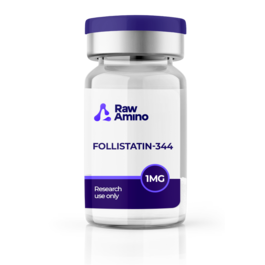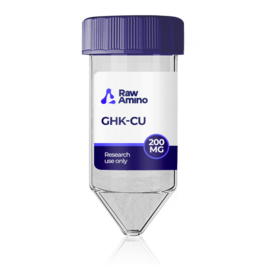
P21 – 5MG
$110.00
Discount per Quantity
| Quantity | Discount | Price |
|---|---|---|
| 5 - 8 | 5% | $104.50 |
| 9 + | 10% | $99.00 |
Scientific Overview of P21 Peptide
P21, also referred to as P021, is a synthetic neurotrophic-related research peptide designed with the intention of mimicking certain actions of ciliary neurotrophic factor (CNTF). CNTF has been studied for its proposed ability to influence neuronal survival and differentiation in experimental contexts. P21 was created following investigations into specific regions of CNTF, with the aim of exploring neurotrophic pathways while reducing potential immune reactivity.
Preclinical work suggests that P21 may influence hippocampal activity, neurogenesis, and synaptic plasticity in murine models. Researchers have theorized that this compound could activate receptor-mediated signaling complexes similar to CNTF, with downstream pathways potentially linked to cognitive processes and neuronal proliferation.
P21 Studies and Research Data
Explorations in Alzheimer’s Disease Models
Several studies have examined P21 in experimental Alzheimer’s disease (AD) frameworks. Chronic exposure in aged murine models appeared to coincide with reduced tau accumulation, both in brain tissue and cerebrospinal fluid. Researchers proposed that this observation may relate to the modulation of pathways involving brain-derived neurotrophic factor (BDNF) and kinases such as GSK-3, which are thought to be involved in tau phosphorylation. Additional work suggested that P21 may have reduced amyloid-beta pathology, supported synaptic marker regulation, and contributed to improved neurobehavioral outcomes in transgenic murine systems.
P21 Investigations in Cognitive Aging
Research has also focused on P21 in models of age-related cognitive changes. Findings suggest that exposure may prevent declines in synaptic plasticity and memory-related processes. Proposed mechanisms include increases in BDNF expression, restoration of synaptic markers such as PSD-95 and MAP2, and a reduction in metabolic changes like elevated myoinositol. These effects are thought to support dendritic stability and neurotransmission in hippocampal and cortical networks.
Research on Synaptic and Neuronal Pathways
Studies indicate that P21 may influence several signaling pathways considered important for neuronal function, including PI3K/Akt, MEK/ERK, and PLC/PKC. In laboratory contexts, these cascades have been linked to neuronal survival, growth, and plasticity. Increased activity of CREB and other transcriptional regulators has also been observed, suggesting a potential role in memory-associated processes.
Experimental Work on Retinal Models
Beyond neural tissues, research has extended into ocular contexts such as age-related macular degeneration (AMD). Long-term exposure in aged and transgenic murine models appeared to prevent hallmark retinal changes including pigment epithelium degeneration, microgliosis, and Bruch’s membrane thickening. Studies also noted possible reductions in abnormal tau, amyloid, and VEGF accumulation within sub-retinal regions, supporting the hypothesis of overlapping features between retinal and neurodegenerative pathways.
Neuroprotective Themes in Early Development
Some investigations introduced P21 during early developmental stages in murine models. Reports suggested that prenatal to postnatal exposure may have prevented cognitive decline, mitigated pathological accumulations of tau and amyloid, and reduced neuroinflammatory markers. The findings point to the possibility that P21 may play a role in stabilizing synaptic development and neurotrophic support during critical periods.
Conclusion
The research landscape surrounding P21 highlights a consistent interest in its potential role across multiple areas, including cognitive aging, Alzheimer’s disease models, synaptic regulation, retinal degeneration, and developmental neurobiology. While many studies suggest encouraging directions, these results remain preliminary, and ongoing work is needed to better clarify mechanisms, reproducibility, and broader implications in controlled laboratory environments.
References
- Baazaoui, N., & Iqbal, K. (2017). Prevention of dendritic and synaptic deficits and cognitive impairment with a neurotrophic compound. Alzheimer's Research & Therapy, 9(1), 45. https://doi.org/10.1186/s13195-017-0273-7
- Wei, W., Liu, Y., Dai, C. L., Baazaoui, N., Tung, Y. C., Liu, F., & Iqbal, K. (2021). Neurotrophic treatment initiated during early postnatal development prevents Alzheimer-like behavior and synaptic dysfunction. Journal of Alzheimer's Disease, 82(2), 631–646. https://doi.org/10.3233/JAD-201599
- Khatoon, S., Chalbot, S., Bolognin, S., Puoliväli, J., & Iqbal, K. (2015). Elevated tau level in aged rat cerebrospinal fluid reduced by treatment with a neurotrophic compound. Journal of Alzheimer's Disease, 47(3), 557–564. https://doi.org/10.3233/JAD-142799
- Bolognin, S., Buffelli, M., Puoliväli, J., & Iqbal, K. (2014). Rescue of cognitive-aging by administration of a neurogenic and/or neurotrophic compound. Neurobiology of Aging, 35(9), 2134–2146. https://doi.org/10.1016/j.neurobiolaging.2014.02.017
- Wei, W., Wang, Y., Liu, Y., Dai, C. L., Tung, Y. C., Liu, F., & Iqbal, K. (2020). Prenatal to early postnatal neurotrophic treatment prevents Alzheimer-like behavior and pathology in mice. Alzheimer's Research & Therapy, 12(1), 102. https://doi.org/10.1186/s13195-020-00666-7
- Li, B., Wanka, L., Blanchard, J., Liu, F., Chohan, M. O., Iqbal, K., & Grundke-Iqbal, I. (2010). Neurotrophic peptides incorporating adamantane improve learning and memory, promote neurogenesis and synaptic plasticity in mice. FEBS Letters, 584(15), 3359–3365. https://doi.org/10.1016/j.febslet.2010.06.025
- Liu, Y., Wei, W., Baazaoui, N., Liu, F., & Iqbal, K. (2019). Inhibition of AMD-like pathology with a neurotrophic compound in aged rats and 3xTg-AD mice. Frontiers in Aging Neuroscience, 11, 309. https://doi.org/10.3389/fnagi.2019.00309
- Baazaoui, N., & Iqbal, K. (2017). Prevention of amyloid-β and tau pathologies, associated neurodegeneration, and cognitive deficit by early treatment with a neurotrophic compound. Journal of Alzheimer's Disease, 58(1), 215–230. https://doi.org/10.3233/JAD-170075
Disclaimer:
The products mentioned are intended solely for laboratory research and in-vitro experimentation. They are not approved for human or animal use of any kind. All details provided are for educational purposes only. By purchasing from this site, you agree to comply with our Terms and Conditions.
12 reviews for P21 – 5MG
Only logged in customers may leave a review.




cheryl wells –
Skyline Jog –
Great!!!
joshua A –
heather Musky –
Heidi Santh –
matthew smith –
Very helpful. Very appreciative of the bacteriostatic water that comes free with some products.
erika Jerald –
bishop jessica –
Cory A –
debbie San –
erin u –
Anthony M –